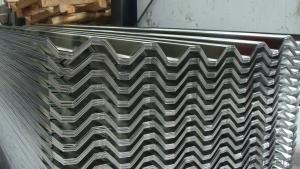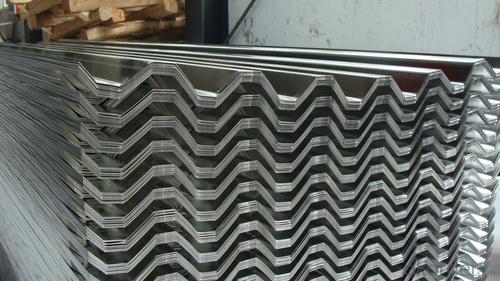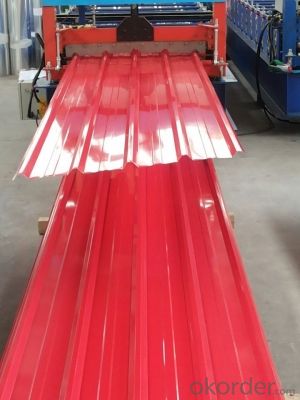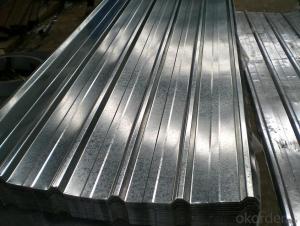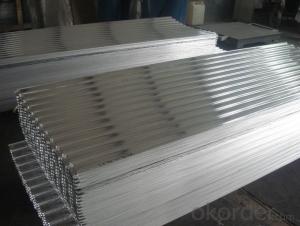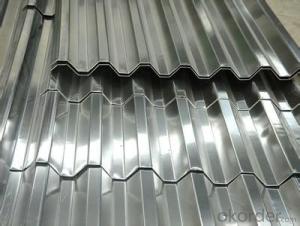Aluminum Sheets in Indiana - Corrugated Aluminum Tile in Different Corrugation Profiles
- Loading Port:
- Tianjin
- Payment Terms:
- TT OR LC
- Min Order Qty:
- 5 m.t.
- Supply Capability:
- 50000 m.t./month
OKorder Service Pledge
OKorder Financial Service
You Might Also Like
Specification
Corrugated Aluminum Tile in Different Corrugation Profiles
Specifications
Alloy NO. | Thickness | Width | Length | Production line | Circulation size |
1050 1060 1100 3003 | 0.3-9.5mm | 800--2200mm | 1000--10000mm | DC,CC | 1220*2440mm 1250*2500mm 1500*3000mm 1000*2000mm
|
5052 5083 5454 5754 5086 | 0.5-150mm | 800--2200mm | 1000--6000mm | DC | |
6061 | 5-150mm | 800--2200mm | 1000--10000mm | DC | |
7075 | 6-150mm | 800--2200mm | 1000--10000mm | DC | |
Packing | Stick blue film→plastic film→waterproof paper→1~2 tons on a export standard pallet(corner protection) | ||||
Application | decoration:ceilings,walls,furniture,cabinets,elevators,signs,name plate, transportation, cookware, household appliances:refrigerators,microwave ovens, machinery, mold making,aerospace and military aspects, auto, PP cap , construction etc | ||||
Standard | Chemical Composite: GB/T 3190-2008, JIS, EN, ASTM | ||||
Mechanical Property: GB/T 3880.2-2012, JIS, EN, ASTM | |||||
MOQ | 5TONS | ||||
Kind attention | Specifications can be customized as the customer’s requirements | ||||
Application

FAQ
Q: Can you provide free samples?
A: Yes, free samples will be sent to you on freight at destination.
Q: Can I get your latest catalogue?
A: Yes, it will be sent to you in no time.
Q: What are your payment terms?
A: We accept L/C, D/A, D/P, T/T, West Union, etc
Q: Can you provide free samples?
A: Yes, free samples will be sent to you on freight at destination.
Q: Can I get your latest catalogue?
A: Yes, it will be sent to you in no time.
Q: What is the MOQ?
A: 5 tons.
- Q: How are aluminum sheets tested for quality and compliance with industry standards?
- Aluminum sheets are tested for quality and compliance with industry standards through various methods such as visual inspection, dimensional measurements, mechanical tests, and chemical analysis. Visual inspection involves checking for surface defects, scratches, and discoloration. Dimensional measurements ensure that the sheets meet the required thickness, width, and length specifications. Mechanical tests assess the strength, hardness, and ductility of the aluminum sheets through techniques like tensile testing and impact testing. Chemical analysis involves determining the chemical composition and purity of the sheets, ensuring they meet the required standards. Overall, these comprehensive testing methods ensure that aluminum sheets adhere to industry quality standards.
- Q: How do you join aluminum sheets together?
- One common method to join aluminum sheets together is through welding. This involves melting the aluminum at the joint and then allowing it to solidify, creating a strong bond. Other methods include using adhesive bonding, riveting, or using mechanical fasteners such as screws or bolts. The choice of joining method depends on factors such as the application, the thickness of the aluminum sheets, and the desired strength and appearance of the joint.
- Q: Are aluminum sheets corrosion-resistant?
- Yes, aluminum sheets are corrosion-resistant due to the formation of a protective oxide layer on their surface.
- Q: This question asks for methods to clean aluminum sheets to preserve their appearance.
- <p>To clean aluminum sheets and maintain their appearance, follow these steps: 1. Use a mild detergent mixed with warm water to create a cleaning solution. 2. Gently scrub the aluminum sheets with a soft cloth or sponge to avoid scratching the surface. 3. Rinse thoroughly with clean water to remove any detergent residue. 4. Dry the sheets immediately with a soft, dry cloth to prevent water spots. 5. For stubborn stains, use a non-abrasive cleaner specifically designed for aluminum. 6. Avoid using harsh chemicals or abrasive materials that can damage the aluminum's finish. Regular cleaning will help preserve the appearance and longevity of aluminum sheets.</p>
- Q: What safety measures should be taken into account when installing aluminum sheets?
- <p>When installing aluminum sheets, it's important to follow safety precautions. Always wear appropriate personal protective equipment, including gloves and safety glasses. Ensure the work area is clear of debris and other hazards. Use the correct tools for cutting and handling aluminum sheets to prevent injuries. Be cautious of sharp edges and corners that can cause cuts. Ensure the aluminum sheets are properly secured to avoid them falling and causing harm. Follow all manufacturer guidelines for installation to ensure the stability and longevity of the aluminum sheets.</p>
- Q: some car manufactures use aluminium car body on a steel sub-frame. explain, using electrode potential what would happen if a weak acid was to become trapped in the space between these two metals!! any current plzz help, its for my assignment, and i dont understand
- Do a google search for electrolysis of an acid.
- Q: What is the typical thickness tolerance for aluminum sheets?
- The typical thickness tolerance for aluminum sheets can vary depending on the specific application and industry standards. However, in general, the accepted thickness tolerance range for aluminum sheets is typically within ± 0.005 to ± 0.015 inches. This means that the actual thickness of the sheet may vary within this tolerance range from the specified thickness. It is important to note that different industries may have different tolerance requirements based on the intended use of the aluminum sheet, so it is always advisable to consult the relevant industry standards or specifications for specific tolerance requirements.
- Q: What are the different types of protective films available for aluminum sheets?
- There exists a variety of protective films for aluminum sheets, each offering distinct features and advantages. Some commonly used types include: 1. Polyethylene (PE) film: PE film is a favored option for safeguarding aluminum sheets due to its versatility and cost-effectiveness. It serves as a temporary shield against scratches, dust, dirt, and moisture during storage, transportation, and fabrication processes. PE film can be effortlessly applied and removed without leaving residue or causing damage to the aluminum sheet's surface. 2. Polyvinyl Chloride (PVC) film: PVC film is another popular protective film for aluminum sheets. It provides excellent protection against scratches, abrasions, and UV rays. Known for its durability, PVC film is suitable for long-term applications. It is available in different thicknesses and can be customized to meet specific requirements. 3. Polyolefin film: Polyolefin film is a type of shrink film that ensures comprehensive protection for aluminum sheets. It exhibits high resistance against punctures, tears, and moisture. By heat-shrinking onto the aluminum surface, polyolefin film creates a secure seal, preventing any damage during handling, storage, or transit. 4. Polyester film: Polyester film is a high-performance protective film that offers exceptional resistance against chemicals, solvents, and extreme temperatures. It serves as an excellent barrier against moisture, preventing corrosion and oxidation of the aluminum sheet. Polyester film is commonly utilized in demanding applications where maximum protection is required. 5. Adhesive-backed film: Adhesive-backed films are self-adhesive protective films that can be easily applied and firmly bonded to aluminum sheets. They provide a temporary protective layer against scratches, stains, and other surface damages. Available with different adhesive strengths, adhesive-backed films can be removed effortlessly without leaving residue or causing harm to the aluminum surface. It is crucial to choose the appropriate type of protective film based on the specific requirements and conditions in which the aluminum sheets will be utilized.
- Q: This question asks for various methods through which aluminum sheets can be recycled and repurposed.
- <p>Aluminum sheets can be recycled and reused in several ways: 1. Melting and Reformation: The most common method is to melt down the aluminum and reform it into new products. 2. Mechanical Recycling: This involves shredding and compacting the aluminum sheets to be used as raw material in new products. 3. Energy Recovery: The heat generated from burning aluminum can be used to produce energy. 4. Alloying: Aluminum can be combined with other metals to create new alloys with different properties. 5. Reuse in Construction: Aluminum sheets can be reused in construction projects, such as facades or roofing. 6. Manufacturing: They can be used in manufacturing processes to create new aluminum products like cans, foils, and automotive parts. Proper recycling of aluminum reduces environmental impact and conserves resources.</p>
- Q: Are aluminum sheets suitable for use in HVAC (heating, ventilation, and air conditioning) systems?
- Aluminum sheets are indeed a fitting choice for HVAC systems. The popularity of aluminum in HVAC systems stems from its numerous advantageous properties. To begin, aluminum is both lightweight and robust, making it effortless to handle and install in HVAC systems. Its low density also enables cost-effective transportation and reduces the overall weight of the HVAC units. Furthermore, aluminum possesses exceptional resistance to corrosion. Given that HVAC systems often encounter moisture and condensation, particularly in air conditioning units, aluminum's corrosion resistance ensures its durability and longevity in such environments. Moreover, aluminum sheets exhibit commendable thermal conductivity, facilitating efficient heat transfer throughout the HVAC system. This property holds particular significance in heating and cooling applications, as it aids in effectively distributing the desired temperature. In addition, aluminum is a non-toxic material, rendering it safe for use in HVAC systems that circulate air within buildings. It does not emit any harmful particles or gases, thereby ensuring the quality of indoor air. Lastly, aluminum is highly recyclable, contributing to its environmental friendliness. The ability to recycle aluminum sheets reduces the carbon footprint associated with HVAC systems and aligns with sustainability objectives. Taking all these advantages into account, aluminum sheets undeniably prove suitable for use in HVAC systems. They offer an optimal combination of strength, corrosion resistance, thermal conductivity, safety, and environmental friendliness.
Send your message to us
Aluminum Sheets in Indiana - Corrugated Aluminum Tile in Different Corrugation Profiles
- Loading Port:
- Tianjin
- Payment Terms:
- TT OR LC
- Min Order Qty:
- 5 m.t.
- Supply Capability:
- 50000 m.t./month
OKorder Service Pledge
OKorder Financial Service
Similar products
Hot products
Hot Searches
Related keywords
